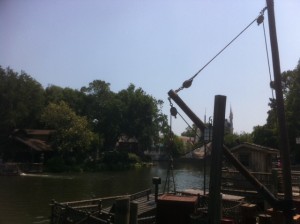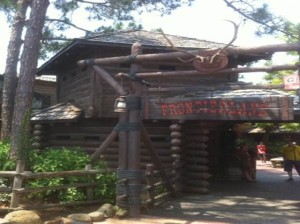Frontierland, Walt Disney, and the American Identity
By Dave Shute
(This post first appeared as a guest post on
MilitaryDisneyTips.com‘s Patriotic Disney series. Thanks, Steve, for letting me republish it here in celebration of Walt Disney World’s 40th Anniversary.)
 FRONTIERLAND: A MUSEUM OF DREAMS
FRONTIERLAND: A MUSEUM OF DREAMS
First, consider birth and death years of three great Americans:
- 1734-1820: Daniel Boone
- 1835-1910: Samuel Langhorne Clemens (that is, Mark Twain)
- 1901-1966: Walt Disney
With just one 15-year gap, these three lives stretch from before the French and Indian wars to the Space Age.
Daniel Boone and Mark Twain both lived and mythologized the American frontier experience; Walt Disney then re-mythologized the frontier into Frontierland, combining the myths of his boyhood with the pioneer and western imagery created by Hollywood.
As Margaret J. King noted, the result is a kind of “museum” for “the most nostalgic images and dreams of a nation.”
The introduction to Frontierland in The Imagineering Field Guide to Magic Kingdom at Walt Disney World is worth quoting in detail:
“Frontierland celebrates the American pioneer spirit. It is the perfect embodiment of the wonder of the unknown and the quest to discover it…Frontierland is often referred to as the most distinctively American statement in all the Magic Kingdom. It lives as a tribute to the pioneer spirit that drove Americans westward…a subject that was as near and dear to Walt as Main Street, U.S.A. and equally connected to the fondest memories from his childhood.” (51-52)
THE GENESIS OF FRONTIERLAND

The idea of Disneyland grew as a series of concepts and sketches.
At the beginning was a train; next came Main Street; further developments of the idea included “an old farm, a western village, an Indian compound…[and] a riverboat.” (Gabler, Walt Disney: The Triumph of the American Imagination 481-485.)
Elements of these early designs became Main Street and Frontierland; what many think the quintessential elements of Disneyland and Disney World–Fantasyland and Tomorrowland–didn’t emerge until later.
This confusion of quintessence comes from our viewing the parks from the eyes of our own childhoods, and not Walt’s.
In the early planning, Walt “described the park as providing a lesson in American heritage” displaying “the kind of bedrock values…that were especially salient with the onset of the Cold War. ‘There’s an American theme behind the whole park,’ ” he said. (Gabler, 499.)
The initial conceptualization–the train, Main Street and Frontierland–recapitulated not only Walt’s childhood, but also the childhood of the nation. Gabler continues: “Disneyland was intended to re-create not only Walt Disney’s moment of possibility but also America’s, when the country, like Walt, had been both innocent and ambitious.” (500, 499.)
THE “OLD WEST” BEGAN IN OHIO, KENTUCKY, AND TENNESSEE
At the time of the revolution, the “west” was not Arizona and California; it was the area west of the Appalachians and the Alleghenies.
These mountains defined the limits of land useful for easterners to farm, and areas to their west–and sometimes the mountains themselves–were excluded to lawful settlement by treaties and laws.
But settlement happened anyway, as bold, daring and ambitious people made their way first into the mountains, via Boone’s Wilderness Road through the Cumberland Gap and via the National Road, and then headed to the great rivers beyond them, particularly the Ohio and Mississippi.
These pioneers found beyond the mountains the world’s largest swath of land perfect for farming, combined with the world’s most penetrating network of navigable rivers.
This geography became destiny.
Settlers could find farmland capable of feeding many more than themselves, ship their agricultural surplus on the navigable waterways, and spend the proceeds on developing their farms and their lives.
None of this was easy. Getting to the west required difficult journeys and backwoods skills. Creating a homestead took years of backbreaking work. Both getting to and thriving in a new land often required surviving multiple bloody Indian attacks, from Indians who often had a treaty right, and always had a moral right, to oppose settlement.
But it happened, and it built in the old west a people who valued individualism, self-reliance, mutual aid, wilderness skills, independence of action, patriotism, honor, martial skills, bravery, and perseverance.
These westerners did not value traditional eastern elites, people telling them what to do, or much in the way of federal power. While the battle over the role of the federal government pre-dated the rise of the west, westerners in particular resisted increases in federal power not only because they saw it as unconstitutional, but also because they resented the eastern elites using it to influence westerner’s lives and enrich easterner’s friends.
These values, and especially their anti-elitism, were different than those of the old mercantile aristocracy of the northeast and those of the slaveholder aristocracy of the south, and the clash of values was put to crisis by the election of Andrew Jackson.
Jackson won, and through Jacksonian democracy’s infusion of frontier values into the political structures created by the elites after the revolution, the beginnings of today’s American identity were forged.
And this is what Frontierland celebrates: the bravery and spirit of adventure of the pioneers; the values they created; and the land that they shaped for their children to grow up in.
FRONTIERLAND BEGINS IN LIBERTY SQUARE
This material continues here.




0 comments
Comment by typing in the form below.
Leave a Comment | Ask a Question | Note a Problem